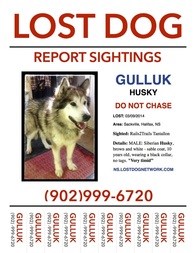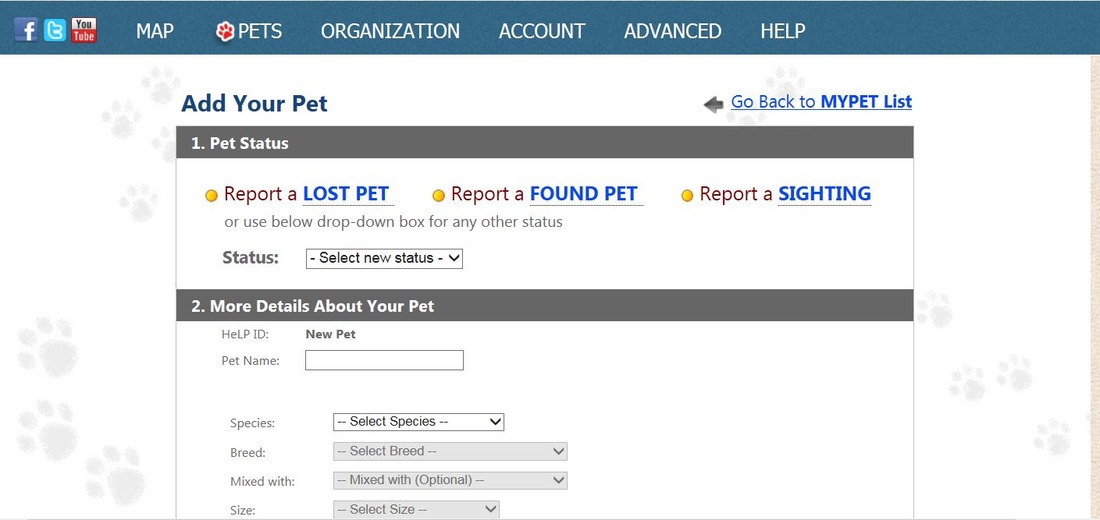 It happens every day. Pets get lost or go missing, people frantically try to find them and in some cases, they never do. As the go-to animal person at my office, I hear about this regularly. The family cat who was scared by fireworks on New Year’s Eve and bolted through an open door. The newly adopted rescue dog who was let outside to relieve herself and ran because she was scared by a car. Maybe the worst one I heard at work was about an elderly dog with limited vision who slipped out a door when some contractors were doing renovation work. The family felt she could not have gone far and did all the right things: searched the neighborhood, knocked on doors, put up flyers, put a “lost” ad in the local paper, put food and her bedding outside. They even went to the municipal animal shelter with photos in hand to look for her, only to be told, “sorry, your dog is not here.” They searched and knocked on doors for days. After almost a week of anguish, the family went back to the shelter one more time on a hunch, only to discover their beloved dog had been there for a week and was scheduled to be euthanized the next day. This family was both lucky and incredibly relieved. Some are not so lucky.  I know that animals end up in shelters for a host of reasons and that some of those reasons have to do with public irresponsibility. But not every animal in a shelter is there because of someone’s fault. We do better at a society to treat each and every shelter animal as someone’s beloved pet who is lost than to presume that “the irresponsible public” does not care enough to keep them safe. Gates get left open by children, contractors pay more attention to ladders and tools than to cats and animals are displaced due to traffic accidents and bad weather. Life happens. It is a reality of our animal sheltering system that healthy and treatable animals are destroyed every day and in most cases these are simply lost pets who could not be identified in order to be reunited with their families. It is a national tragedy. I’m a huge proponent of microchipping all pets whether they live inside of not. You simply must prepare for the possibility that they may end up outside and while collars and tags are also advised (with breakaway collars for cats for safety purposes), nothing can really take the place of what amounts to a barcode for your companion animal to help them be identified if they get lost and end up in a shelter, with a rescue group or at a veterinary office. Most microchips cost very little, including lifetime registration, and really can make the difference in ensuring your pet can be identified if he or she is lost (or even if they are stolen). If you do a simple search on social media using the words “lost found pet” you will come up with a variety of groups and pages all trying to help people find lost pets or trying to reunite found pets with the families searching for them. As valuable as these pages may be, they all have one thing in common. They are geography specific. Just because your dog goes missing from your home in X city doesn’t mean he or she will stay in that city. He may very well end up in Y county for whatever reason and you may never know that. Animals don’t know geographic boundaries and the reality is that once your dog or cat is outside of your control, you really never know how far they will travel either on foot, in the back of a truck bed or in a vehicle or even taken an unknown distance by a good Samaritan who is simply trying to help them. All this leads to an announcement about a wonderful new tool in our animal lover’s toolbox I learned about recently: a website called Helping Lost Pets (HeLP). The website has been active since 2010 and is used across Canada and the United States. The site is the brainchild of Rob Goddard of Goddard Information Systems Limited and is currently funded by his company (with hopes to be funded by sponsors and advertising at some point). I learned about Helping Lost Pets just recently and I’ve been telling everyone I know about it because it’s just such an incredible tool. The concept is simple: the website is a map-based site and is free to use for shelters and animal owners alike. If you run a shelter or animal control department and you pick up animals running at large or found animals reported to you, you enter them on the site with an image and some basics about where they were found. This allows pet owners to look for their lost pets. If you are an animal caregiver and your pet goes missing, you enter them on the site with an image and some basics about where they belong. This allows animal control personnel and social media platforms to help reunite lost pets with their families. Helping Lost Pets describes the website this way: HelpingLostPets.com (HeLP) is a FREE nationwide database for lost and found pets that connects shelters, veterinary clinics, rescue groups, the public, and volunteer groups across the nation to effectively reunite lost pets with their owners. What makes HeLP unique is it is mapbased and fully searchable by breed, location, size, color, gender, and other identifiable information, making it easy to match lost and found pet listings. To ensure our listings stay current, our system automatically contacts owners/finders for status updates at defined intervals. This allows our system to remain uptodate and display only pets that are still missing and truly need our help getting home. We have found that flyers are one of the most effective ways to reunite a lost pet. When someone list a pet, free flyers are instantly generated to provide an effective tool in getting a pet home. What makes the website even more powerful is the many volunteer groups across the country that also use the website to help pets get back home. Lost Dogs of America is their largest partner with chapters in over 30 states now.
If you manage or are affiliated with an animal control agency, rescue group or veterinary office which often takes in lost pets, I cannot encourage you strongly enough to learn about this wonderful resource. If you are a pet owner, I encourage you to take all the normal steps to find your pet: talking to your neighbors, putting up flyers, putting an ad in a local paper, posting on social media, putting food and bedding outside, etc. Having a pet go missing to never be found again can be a life-altering experience for you and can be a life-ending experience for your pet. Please use HeLP. It’s quick, it’s free and you just never know when using that one extra tool in the toolbox will help you be reunited with your beloved companion. Lost Dog Recovery Tips: http://lostdogsofamerica.org/lost-dog/recovery-procedures/ Lost Cat Recovery Tips: http://www.missingpetpartnership.org/recovery-tips/lost-cat-behavior/
4 Comments
Brian Gold
12/9/2016 11:46:25 am
As it happens, one of our cats who had been missing for 10 days just ran in the catdoor yelling for food. A little skinny and a bit scuffed up but fine. Losing a pet is truly one of the worst experiences. The only frustration that remains when a lost pet returns is usually not having any idea where the hell they have been. In Harvey's case, we were pretty sure he wasn't lost but that he might be seriously injured or trapped somewhere.
Reply
Paws4Change
12/9/2016 12:29:54 pm
I'm so thrilled Harvey returned! And you make a great point about mail so thanks for sharing that.
Reply
12/9/2016 06:43:21 pm
We want to thank you for such an informative blog about what to do if your pet is missing. We are also thankful to have you include information about us and how the website works. Finally, a BIG THANKS for all you are doing to save pets !!
Reply
Your comment will be posted after it is approved.
Leave a Reply. |
AuthorI am an animal welfare advocate. My goal is to help people understand some basic issues related to companion animals in America. Awareness leads to education leads to action leads to change. Archives
July 2024
Categories
All
image courtesy of Terrah Johnson
|




 RSS Feed
RSS Feed